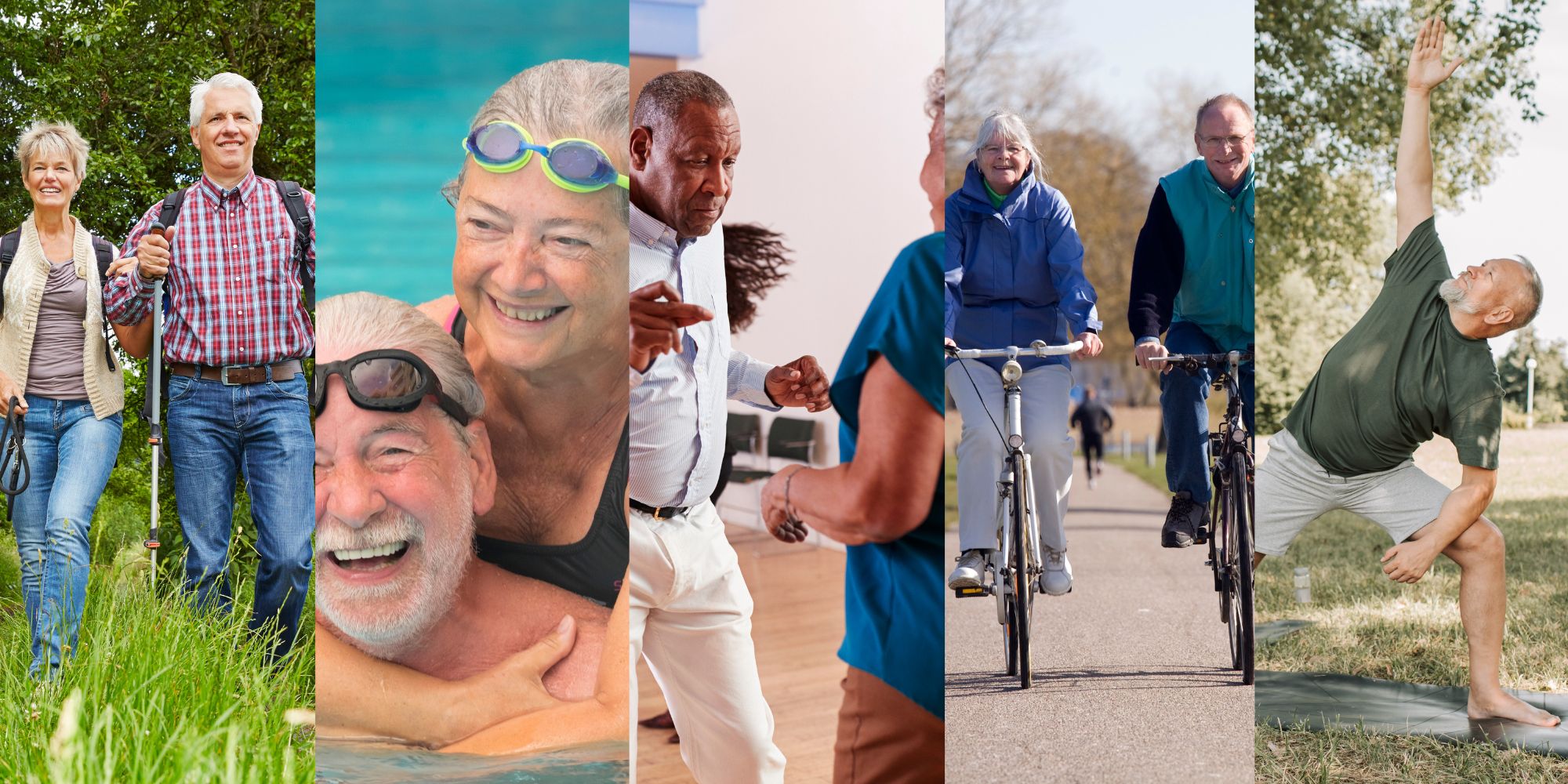Whether you’re a seasoned fitness enthusiast or just starting your journey, keeping active as you age is key to maintaining a healthy, happy life. In this article, we’ll explore a range of fitness tips for seniors. Let’s dive in!
1. Walking: A Simple Start
Walking is the most accessible form of exercise and an excellent way to stay fit. Whether it’s a stroll around your local park, a hike in the countryside, or just a walk to the shops, it’s easy to fit into your daily routine. When considering fitness tips for seniors, walking is a highly recommended activity due to its simplicity and effectiveness.
Benefits:
- Cardiovascular health: Regular walking helps keep your heart healthy by improving circulation and lowering blood pressure.
- Joint health: It’s gentle on the joints, reducing the risk of arthritis. Walking helps lubricate and strengthen the muscles that support your joints.
- Mental health: Walking outdoors boosts mood and reduces stress. Fresh air, sunlight, and the rhythmic nature of walking can all contribute to a sense of well-being.
Getting Started:
Begin with short, manageable walks and gradually increase your distance and pace. Invest in a comfortable pair of walking shoes and consider joining a local walking group for social support and motivation.
2. Yoga: Flexibility and Balance
Yoga is fantastic for improving flexibility, balance, and strength. There are many classes available specifically for seniors, both online and in community centres.
Benefits:
- Flexibility: Regular practice can significantly improve your range of motion, making daily activities easier.
- Balance: Helps prevent falls by strengthening stabilizing muscles and improving coordination.
- Mindfulness: Encourages relaxation and stress relief through deep breathing and meditation techniques.
Getting Started:
Look for a “gentle” or “senior” yoga class in your area. Online platforms like YouTube also offer senior-specific yoga routines. All you need is a yoga mat and some comfortable clothing. If you have mobility issues, chair yoga is a great alternative.
3. Aqua Aerobics: Fun in the Water
Aqua aerobics is a low-impact, full-body workout that takes place in a pool. It’s great for those with joint issues or anyone looking for a fun way to exercise.
Benefits:
- Low impact: Water supports your body, reducing strain on joints and making it an ideal exercise for arthritis sufferers.
- Resistance: The water provides natural resistance, building strength without the need for weights.
- Social: Classes are often sociable and a great way to meet new people, which can enhance mental well-being.
Getting Started:
Many local leisure centres offer aqua aerobics classes. Bring a swimsuit, towel, and water shoes if you prefer extra grip on the pool floor. Classes typically last around 45 minutes and are set to music, making them enjoyable and lively.
4. Tai Chi: Gentle Movement
Tai Chi is a form of martial arts known for its slow, deliberate movements. It’s particularly beneficial for improving balance and coordination.
Benefits:
- Balance: Enhances stability and reduces the risk of falls by strengthening the legs and core.
- Stress reduction: The meditative nature of Tai Chi can help lower stress levels and improve mental clarity.
- Flexibility: Improves overall flexibility and joint mobility, making daily activities easier.
Getting Started:
Tai Chi classes are often available at community centres or through local councils. You don’t need any special equipment, just comfortable clothing. Start with a beginner’s class to learn the basic movements and gradually progress.
5. Strength Training: Building Muscle
Strength training is not just for the young! Using light weights or resistance bands can help build and maintain muscle mass, which is crucial as we age. Among the many fitness tips for seniors, strength training stands out for its benefits in maintaining muscle and bone health.
Benefits:
- Bone density: Helps maintain and improve bone density, reducing the risk of osteoporosis.
- Muscle mass: Prevents muscle loss, improving overall strength and functional ability.
- Metabolism: Boosts metabolism, aiding in weight management and overall energy levels.
Getting Started:
Begin with light weights or resistance bands. Focus on major muscle groups like legs, arms, and core. Aim for two sessions per week, with exercises such as bicep curls, leg lifts, and seated rows. Always warm up before and cool down after your workouts.
6. Gardening: An Active Hobby
Gardening is more than just a hobby; it’s a great way to stay active. Digging, planting, weeding, and harvesting all involve physical activity.
Benefits:
- Physical activity: Engages different muscle groups and provides a moderate cardiovascular workout.
- Vitamin D: Exposure to sunlight helps produce vitamin D, essential for bone health.
- Mental health: Being in nature reduces stress and promotes well-being, while the satisfaction of nurturing plants can boost mood.
Getting Started:
Start with simple tasks like planting flowers or vegetables in pots if you don’t have a garden. Use ergonomic tools to prevent strain and take frequent breaks to avoid overexertion. Enjoy the process and the joy of watching your garden grow.
7. Dancing: Move to the Music
Dancing is a fun way to stay fit. Whether it’s ballroom, line dancing, or just grooving to your favourite tunes at home, it gets your heart pumping.
Benefits:
- Cardiovascular health: Great for heart health and endurance, as it keeps your heart rate elevated.
- Coordination: Improves coordination and balance, which can help prevent falls.
- Social interaction: Dance classes provide a social outlet, which is beneficial for mental health.
Getting Started:
Join a local dance class or find online tutorials for your favourite dance styles. Wear comfortable clothing and shoes suitable for dancing. Start slow and gradually build up to more complex routines as your confidence grows.
8. Cycling: Pedal Power
Cycling, whether on a traditional bike or a stationary one, is excellent for cardiovascular health and muscle strength.
Benefits:
- Low impact: Easier on the joints compared to running, making it suitable for those with knee or hip issues.
- Cardio: Improves heart health and stamina, enhancing overall cardiovascular fitness.
- Strength: Builds leg strength and endurance, particularly in the quadriceps, hamstrings, and calves.
Getting Started:
If you prefer outdoor cycling, choose flat, safe routes and always wear a helmet. For indoor cycling, consider a stationary bike or a cycling class at your local gym. Start with short rides and gradually increase your duration and intensity.
9. Pilates: Core Strength
Pilates focuses on core strength, flexibility, and overall body awareness. It’s suitable for all fitness levels and can be done on a mat or using special equipment.
Benefits:
- Core strength: Improves stability and balance, which is essential for daily activities and fall prevention.
- Flexibility: Enhances overall flexibility, reducing the risk of injury.
- Posture: Promotes better posture and alignment, which can alleviate back pain and improve breathing.
Getting Started:
Find a senior-friendly Pilates class or follow online routines designed for beginners. You’ll need a mat and comfortable clothing. Pilates involves controlled movements and breathing, so take your time to learn the correct techniques.
10. Hiking: Explore the Outdoors
Hiking combines the benefits of walking with the added challenge of varied terrain. It’s a wonderful way to explore the beautiful countryside.
Benefits:
- Cardiovascular health: Strengthens the heart and lungs, improving overall fitness.
- Strength: Works various muscle groups, including the legs, core, and upper body.
- Mental health: Nature exposure boosts mood and reduces stress, providing a sense of adventure and accomplishment.
Getting Started:
Choose well-marked trails that match your fitness level. Wear sturdy hiking boots and bring essentials like water, a map, and weather-appropriate clothing. Start with shorter hikes and gradually tackle longer, more challenging routes as you build endurance.
11. Swimming: Full-Body Workout
Swimming is a low-impact, full-body exercise that’s particularly kind to the joints. It’s a great way to stay fit without putting stress on your body.
Benefits:
- Low impact: Gentle on the joints and ideal for those with arthritis or mobility issues.
- Full-body: Engages multiple muscle groups, including the arms, legs, and core.
- Cardiovascular health: Improves heart and lung function, enhancing overall cardiovascular fitness.
Getting Started:
Find a local swimming pool and aim for regular swimming sessions. Many pools offer senior swim times or aqua fitness classes. Bring a swimsuit, goggles, and a towel. Start with short, leisurely swims and gradually increase your distance and pace.
Conclusion
Staying active as a senior is not only possible but enjoyable with these varied fitness activities. Whether you prefer the gentle movements of Tai Chi, the social aspect of dancing, or the tranquillity of gardening, there’s something for everyone. Remember, the key is to find an activity you love and make it a regular part of your routine. With these fitness tips for seniors, you can stay fit, healthy, and happy!
Additional Resources
For more information and helpful tips on staying active and healthy as a senior, check out these additional resources:
- NHS Fitness Studio – Offers a variety of workout videos suitable for all fitness levels, including specific exercises for seniors.
- Age UK: Exercises for Older Adults – Provides comprehensive advice on exercises tailored for older adults to help maintain health and mobility.
- British Heart Foundation: Staying Active – Offers practical tips and guidelines for staying active to support heart health.
- Saga: Standing Pilates for Seniors Workout – Features a Pilates workout specifically designed for seniors to improve strength and balance.

